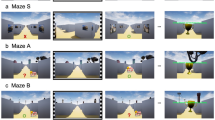Abstract
Cognitive representation of the overall layout of an environment provides information about the relative location of fixed sites in the setting which can be used for orientation purposes while navigating. It was suggested, however, that reliance on geographical orientation in way-finding is most likely in relatively undifferentiated settings. In differentiated settings individuals will tend to utilize environmental features, i.e., landmarks, in way-finding. This hypothesis was examined through two studies. In a laboratory investigation using a videotape of a walk through a neighborhood, subjects were able to learn the route in spite of the fact that the procedure minimized opportunities for geographical orientation, and landscape features appeared to play a significant role. In a field study which was conducted in a wooded area, one group of subjects was exposed to a route which contained prominent objects at each choice, while a second group initially experienced the route without the presence of such features. A subsequent test of way-finding failed to reveal a significant difference in performance errors between the two groups; however, the way-finding strategies adopted by subjects in each condition varied. While specific features and characteristics of the setting seemed to be utilized in route-learning, as well as memory for specific turns per se, geographical orientation did not appear to play an important role.
Similar content being viewed by others
References
Acredolo, L. P. Development of spatial orientation in infancy.Developmental Psychology, 1978,14, 224–234.
Acredolo, L. P., Pick, H. L., & Olsen, M. G. Environmental differentiation and unfamiliarity as determinants of children's memory for spatial location.Developmental Psychology, 1975,11, 495–501.
Downs, R. M., & Stea, D.Image and environment. Chicago: Aldine, 1973a.
Downs, R. M., & Stea, D. Cognitive maps and spatial behavior: Process and products. In R. M. Downs & D. Stea (Eds.),Image and environment. Chicago: Aldine, 1973b.
Galler, S. R., Schmidt-Koenig, K., Jacobs, G. J., & Belleville, R. E.Animal orientation and navigation. Washington, D.C.: National Aeronautics and Space Administration (NASA SP-262), 1972.
Hardwick, D. A., McIntyre, C. W., & Pick, H. L. The content and manipulation of cognitive maps in children and adults.Monographs of the Society for Research in Child Development, 1976,41, (3, Serial No. 113).
Hart, R. A., & Moore, G. T. The development of spatial cognition: A review. In R. M. Downs & D. Stea (Eds.),Image and environment. Chicago: Aldine, 1973.
Moore, G. T., & Golledge, R. G.Environmental knowing. Stroudsburg, Pa.: Dowden, Hutchinson, & Ross, 1976.
Orr, R. T.Animals in migration. New York: Macmillan, 1970.
Siegel, A. W., & White, S. H. The development of spatial representations of large-scale environments. In H. W. Reese (Ed.),Advances in child development and behavior (Vol. 10). New York: Academic Press, 1975.
Tolman, E. C. Cognitive maps in rats and men,Psychological Review, 1948,55, 189–208.
Winer, B. J.Statistical principles in experimental design. New York: McGraw-Hill, 1971.
Wohlwill, J. F. The environment is not in the head! In W. F. E. Preiser (Ed.),Environmental design research (Vol. 2) (EDRA IV Proceedings). Stroudsburg, Pa.: Dowden, Hutchinson, & Ross, 1973.
Wohlwill, J. F. Searching for the environment in environmental research: A commentary on research strategy. In G. T. Moore & R. G. Golledge (Eds.),Environmental knowing. Stroudsburg, Pa.: Dowden, Hutchinson, & Ross, 1976.
Author information
Authors and Affiliations
Additional information
The research for this article was supported by funds provided by the Denison University Research Foundation. A portion of the data (Study 1) was presented at the meetings of the Eastern Psychological Association, March 1978. The author would like to thank Dean H. Owen, Robert H. Daubert, and Dene S. Berman for their helpful comments on the manuscript; and would especially like to acknowledge the conscientious efforts of Karen Swagart, who assisted in all phases of the project, and Elizabeth Clark, William Hayashi, and Amy Aldred who helped in the data collection. The cooperation of Robert Alrutz, Director of the Denison University Biological Reserve and the Ohio Department of Highways is also most appreciated.
Rights and permissions
About this article
Cite this article
Heft, H. The role of environmental features in route-learning: Two exploratory studies of way-finding. J Nonverbal Behav 3, 172–185 (1979). https://doi.org/10.1007/BF01142591
Issue Date:
DOI: https://doi.org/10.1007/BF01142591




